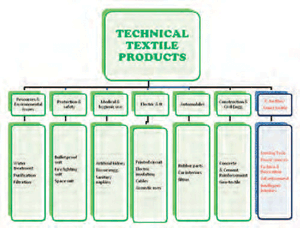
Application of steel yarn in technical textile
Steel filament conductive yarns show good electrical conductivity, with a possibility of various applications ranging from apparels, handicrafts to sub-soil applications, say Unnati S Thakor, DA Vasavada and LS Thakur, who also find low cost technology
Steel filament conductive yarns show good electrical conductivity, with a possibility of various applications ranging from apparels, handicrafts to sub-soil applications, say Unnati S Thakor, DA Vasavada and LS Thakur, who also find low cost technology can be useful to a weaver to earn more by producing these value-added products.
Technical textile has never been a single coherent industry sector and market segment. It has developed in many different directions with varying speed and levels of success. There is continual erosion of the barriers between traditional definitions of textiles and other flexible engineering materials such as paper and plastics, films and membranes, metals, glass and ceramics. What most participants have in common are many of the basic textile skills of manipulating fibres, fabrics and finishing techniques as well as an understanding of how all these interact and perform in different combinations and environments. Beyond that, much of technology and expertise association with the industry resides in an understanding of the needs and dynamics of many very different end-uses and market sectors. It is here that the new dividing lines within the industry are emerging. The term technical textile here means "technical textile which have at least some technological advancement in the market and/or in application".
Generally, the reason why fibre material among several forms of materials are used for certain specified technical products is that the textile products in which some of the configurational function of the fibre are effectively utilised can have the highest value in terms of the ratio (performance/cost).
Application areas of technical textiles
Technical textiles have wide range of applications as shown in the chart given. A particular area of interest is Smart Textile/E-textile, wherein electrical conductive property of fibre/yarn is of prime importance, and study of smart textile is reduced to a study of smart material. The most common accepted definition is that intelligent materials and systems are capable to sense and respond to their surrounding environment in a predictable and useful manner. Smart materials arise from research in many different fields. There is a substantive difference between the terms, Smart and Intelligent, smart materials or textiles can be defined as the materials and structures which have sense or can sense the environmental conditions or stimuli, whereas intelligent textiles can be defined as textile structures which not only can sense but can also react and respond to environmental conditions or stimuli. These stimuli as well as response, could be thermal, chemical, mechanical, electric, magnetic or from other source. Smart fabrics are ones which can change/react automatically to their surroundings. Smart fabrics (-or intelligent textiles) are being developed to be able to sense what is happening to the wearer or its immediate surroundings.
The promise of smart fabrics is that everyday clothing will be able to perform the task of comfort and protection more effectively or add Internet connectivity to allow people to be looked after when something goes wrong. Smart textiles are no longer a science-fiction fantasy. For example, there are in the market self-cleaning carpets, memory-shaped and environment-responsive textiles, and anti-insomniac micro-fibres. The definition of smart textile applies very well to a smart textile system. However, often the sensing function alone is taken as sufficient enough to constitute smartness in textiles.
To enable the textile product to be smart/ intelligent, one of the prime requirements is it should be electrically conductive, which can be accomplished by the use of conductive yarn.
Conductive fibres
The performance of textiles is generally dependent on a) material of fibre, b) conf




